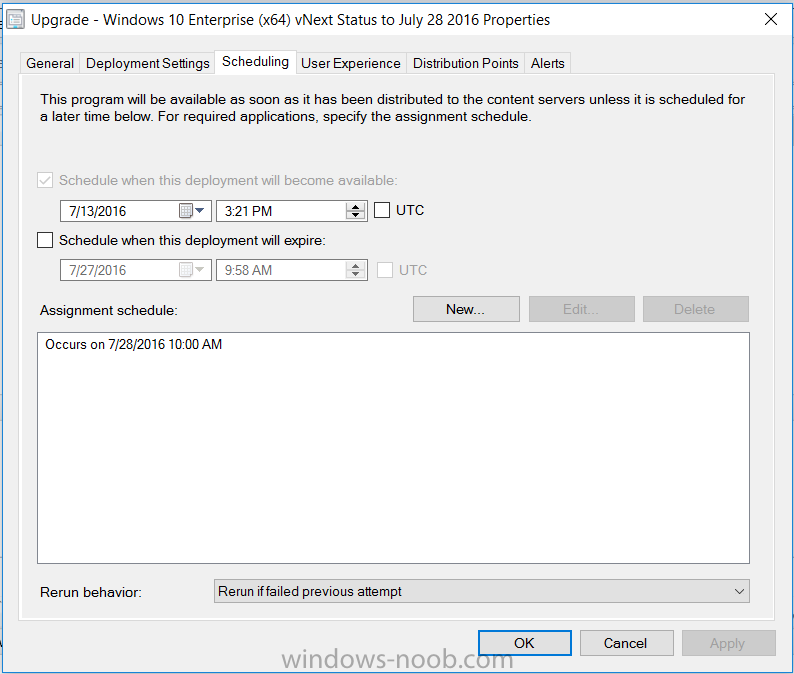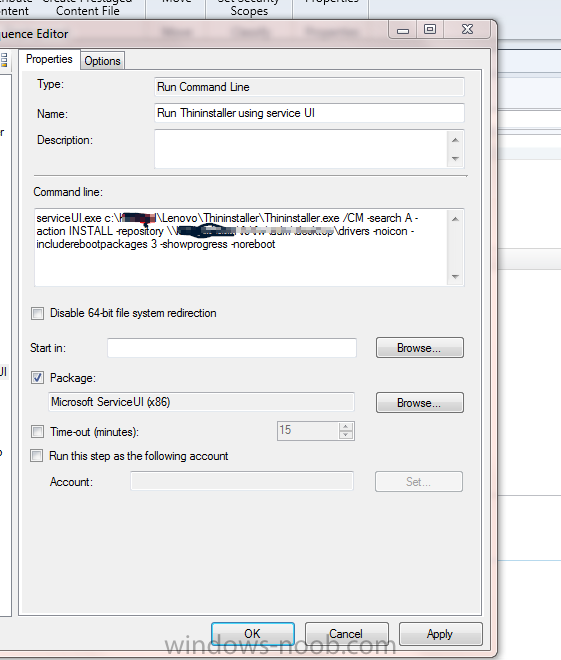Search the Community
Showing results for tags 'SCCM 2012'.
-
Hi All Has anyone used supersedence with Applications? I am happy with the basic process of how supersedence works and how it will now deal with dependant applications that are attached to a main application. We also use our applications in a task sequence and I don't want to, at this stage, disrupt OS deployments. If I set a new application to superseed an old one, will the old application that is still in the task sequence begin to install the new main application? Thanks
-
- Supersedence
- SCCM 2012
-
(and 1 more)
Tagged with:
-
Hi, We have around 500 machines deployed across multiple sites which we have noticed that around 60% of these are now showing inactive. As a comparison, I have found 2 machines, one active, one inactive, both from the same site in the same boundary, to try and figure out why they may be inactive. I Have attached multiple logs for both machines, does anyone have any insight into what may be causing this? We are currently running on 2012 R2 SP1. server 2012 R2 Any other suggestions on where to begin to look or if there are any other server/client logs to go through, would be great . (ACTIVE) CAS.log (ACTIVE) CcmExec.log (ACTIVE) ClientIDManagerStartup.log (ACTIVE) StatusAgent.log (INACTIVE) CAS.log (INACTIVE) CcmExec.log (INACTIVE) ClientIDManagerStartup.log (INACTIVE) StatusAgent.log
- 3 replies
-
- inactive
- sccm 2012 r2
-
(and 3 more)
Tagged with:
-
If I take a machine from the office to home, the Configuration Manager does show Internet. We have a management point on the DMZ that the machine connects to get a list of updates. It looks like the workstation is making communication with that server based on the logs. What is not happening is the actual successful download of the patches and the installation of them. I read that the internet client should go to Microsoft updates first and then to a dp? We do not have a dp setup for the internet clients, as we want them to only download from the Microsoft, yet the packets I capture only point to the management point on the dmz. Any direction would be appreciated on getting these machines to download from windows update!
-
- sccm 2012
- internet client
-
(and 1 more)
Tagged with:
-
Hello All, I have a Powershell script that I use to create multiple Software Update Deployments and it works perfectly (well almost). The last piece I'm missing is automating the deadline date. Currently I just have it getting the current date and adding 5 days. I then go into each deployments properties and change the date/time to the desired info. I've been trying to work out automating this a little bit by adding a variable for a static date/time. I can then change this date (time will always be the same) to the desired info at script run. Below is what I've come up with so far. The -EnforcementDeadlineDay piece works on it own, in that it outputs the correct date with an incremented time. However once I put it in the full script i get the below errors. Any help is much appreciated. Cheers, Mike Script: # Monthly Deployment Date #$DeploymentDate = Get-Date -Format "yyyy-MM" $DeploymentDate = (Get-Date).AddDays(-30).ToString("yyyy-MM") $DeadlineDate = Get-Date -Month 08 -Day 07 -Year 2016 -Hour 17 -Minute 0 -Second 0 # Software Update Groups $SUPGroupName1 = "EN5 - EDC - Year 2013- ($DeploymentDate) Reference 1" $SUPGroupName2 = "EN5 - EDC - Year 2013+ ($DeploymentDate) Reference 2" #Load Configuration Manager PowerShell Module Import-module ($Env:SMS_ADMIN_UI_PATH.Substring(0,$Env:SMS_ADMIN_UI_PATH.Length-5) + '\ConfigurationManager.psd1') #Get SiteCode and set Powershell Drive $SiteCode = Get-PSDrive -PSProvider CMSITE Set-location $SiteCode":" # Create Standard Deployments (Group 1) $DeploymentName = "EN5 - PM Dev ($DeploymentDate) Reboot Deployment # 1" $DeploymentCount = 6 $Count = 0 1..$DeploymentCount | ForEach-Object { $Count++ Write-Progress -Activity "Creating Deployment Group 1" -Id 1 -Status "Running $($Count) / $($DeploymentCount)" -PercentComplete (($Count / $DeploymentCount) * 100) Start-CMSoftwareUpdateDeployment -SoftwareUpdateGroupName "$SUPGroupName1" -CollectionName "EN5 - PM - Deployment $Count (Lab)" -DeploymentName "$DeploymentName-$Count" -DeploymentType Required -VerbosityLevel AllMessages -TimeBasedOn LocalTime -DeploymentAvailableDay (Get-Date) -EnforcementDeadlineDay $DeadlineDate.ToLongDateString()$DeadlineDate.Addhours($Count).ToLongTimeString() -UserNotification HideAll -SoftwareInstallation $True -AllowRestart $True -RestartServer $False -RestartWorkstation $False -ProtectedType RemoteDistributionPoint -UnprotectedType UnprotectedDistributionPoint -GenerateSuccessAlert $False -DisableOperationsManagerAlert $False -GenerateOperationsManagerAlert $False -PersistOnWriteFilterDevice $False -UseBranchCache $False } Write-Progress -Activity "Creating Deployment Group 1" -Id 1 -Completed Errors: Start-CMSoftwareUpdateDeployment : A positional parameter cannot be found that accepts argument '6:00:00 PM'. At E:\scripts\EN5 - CreateDeployments - LAB.ps1:24 char:5 + Start-CMSoftwareUpdateDeployment -SoftwareUpdateGroupName "$SUPGroupName1" - ... + ~~~~~~~~~~~~~~~~~~~~~~~~~~~~~~~~~~~~~~~~~~~~~~~~~~~~~~~~~~~~~~~~~~~~~~~~~~~~~~~~ + CategoryInfo : InvalidArgument: ( [Start-CMSoftwareUpdateDeployment], ParameterBindingException + FullyQualifiedErrorId : PositionalParameterNotFound,Microsoft.ConfigurationManagement.Cmdlets.Sum.Commands.StartSoftwareUpdateDeploymentCommand Start-CMSoftwareUpdateDeployment : A positional parameter cannot be found that accepts argument '7:00:00 PM'. At E:\scripts\EN5 - CreateDeployments - LAB.ps1:24 char:5 + Start-CMSoftwareUpdateDeployment -SoftwareUpdateGroupName "$SUPGroupName1" - ... + ~~~~~~~~~~~~~~~~~~~~~~~~~~~~~~~~~~~~~~~~~~~~~~~~~~~~~~~~~~~~~~~~~~~~~~~~~~~~~~~~ + CategoryInfo : InvalidArgument: ( [Start-CMSoftwareUpdateDeployment], ParameterBindingException + FullyQualifiedErrorId : PositionalParameterNotFound,Microsoft.ConfigurationManagement.Cmdlets.Sum.Commands.StartSoftwareUpdateDeploymentCommand Start-CMSoftwareUpdateDeployment : A positional parameter cannot be found that accepts argument '8:00:00 PM'. At E:\scripts\EN5 - CreateDeployments - LAB.ps1:24 char:5 + Start-CMSoftwareUpdateDeployment -SoftwareUpdateGroupName "$SUPGroupName1" - ... + ~~~~~~~~~~~~~~~~~~~~~~~~~~~~~~~~~~~~~~~~~~~~~~~~~~~~~~~~~~~~~~~~~~~~~~~~~~~~~~~~ + CategoryInfo : InvalidArgument: ( [Start-CMSoftwareUpdateDeployment], ParameterBindingException + FullyQualifiedErrorId : PositionalParameterNotFound,Microsoft.ConfigurationManagement.Cmdlets.Sum.Commands.StartSoftwareUpdateDeploymentCommand Start-CMSoftwareUpdateDeployment : A positional parameter cannot be found that accepts argument '9:00:00 PM'. At E:\scripts\EN5 - CreateDeployments - LAB.ps1:24 char:5 + Start-CMSoftwareUpdateDeployment -SoftwareUpdateGroupName "$SUPGroupName1" - ... + ~~~~~~~~~~~~~~~~~~~~~~~~~~~~~~~~~~~~~~~~~~~~~~~~~~~~~~~~~~~~~~~~~~~~~~~~~~~~~~~~ + CategoryInfo : InvalidArgument: ( [Start-CMSoftwareUpdateDeployment], ParameterBindingException + FullyQualifiedErrorId : PositionalParameterNotFound,Microsoft.ConfigurationManagement.Cmdlets.Sum.Commands.StartSoftwareUpdateDeploymentCommand Start-CMSoftwareUpdateDeployment : A positional parameter cannot be found that accepts argument '10:00:00 PM'. At E:\scripts\EN5 - CreateDeployments - LAB.ps1:24 char:5 + Start-CMSoftwareUpdateDeployment -SoftwareUpdateGroupName "$SUPGroupName1" - ... + ~~~~~~~~~~~~~~~~~~~~~~~~~~~~~~~~~~~~~~~~~~~~~~~~~~~~~~~~~~~~~~~~~~~~~~~~~~~~~~~~ + CategoryInfo : InvalidArgument: ( [Start-CMSoftwareUpdateDeployment], ParameterBindingException + FullyQualifiedErrorId : PositionalParameterNotFound,Microsoft.ConfigurationManagement.Cmdlets.Sum.Commands.StartSoftwareUpdateDeploymentCommand Start-CMSoftwareUpdateDeployment : A positional parameter cannot be found that accepts argument '11:00:00 PM'. At E:\scripts\EN5 - CreateDeployments - LAB.ps1:24 char:5 + Start-CMSoftwareUpdateDeployment -SoftwareUpdateGroupName "$SUPGroupName1" - ... + ~~~~~~~~~~~~~~~~~~~~~~~~~~~~~~~~~~~~~~~~~~~~~~~~~~~~~~~~~~~~~~~~~~~~~~~~~~~~~~~~ + CategoryInfo : InvalidArgument: ( [Start-CMSoftwareUpdateDeployment], ParameterBindingException + FullyQualifiedErrorId : PositionalParameterNotFound,Microsoft.ConfigurationManagement.Cmdlets.Sum.Commands.StartSoftwareUpdateDeploymentCommand
- 2 replies
-
- SCCM 2012
- Powershell
- (and 3 more)
-
Hi All Since we have upgraded our SCCM 2012 config mgr environment to update 1511 and upgraded our clients, first using the auto upgrade which proved problematic and then client push methods quite a few of the clients appear to be failing the client remediation and re-installing, often breaking the client requiring manual intervention. So far approx 150 clients have repaired themselves and utilised default settings contained in the SWDistSchema.mof file on the client machine which set the client cache location to C:\CCM\Cache and a size of just 250mb Reading posts online suggest the problem is present in update 1602. Anyone else experience this and found a fix?
-
I am working on a Windows 10 pilot and trying to make a deployment available for users until a certain date. At that specific date I would like the task sequence to forcefully install. I have attached a pic of my current settings. It expires and forcefully installs but it does not allow the user to install prior at their convenience. Could anyone point me in the right direction? Thanks, RK
-
I have a batch file that if I run locally on a test computer it will correct a Skype for Business 2016 shortcut problem in the start menu by replacing the shortcut with a functional one with no problem. However, I'm having trouble deploying the batch file using as an Application through SCCM 2012 R2. The application deploys and "Installs" but for some reason the batch file never runs and completes the fix. Is there something I need to change on the line for the Installation Program: "filename.bat" under the Programs tab or maybe modify the batch file? Thanks. @ECHO OFF set SCRIPT="%TEMP%\%RANDOM%-%RANDOM%-%RANDOM%-%RANDOM%.vbs" del "C:\ProgramData\Microsoft\Windows\Start Menu\Programs\Skype for Business 2016.lnk" echo Set oWS = WScript.CreateObject("WScript.Shell") >> %SCRIPT% echo sLinkFile = "C:\ProgramData\Microsoft\Windows\Start Menu\Programs\Skype for Business 2016.lnk" >> %SCRIPT% echo Set oLink = oWS.CreateShortcut(sLinkFile) >> %SCRIPT% echo oLink.TargetPath = "C:\Program Files\Microsoft Office\Office16\lync.exe" >> %SCRIPT% echo oLink.WorkingDirectory ="%SYSTEMDRIVE%\Program Files" >> %SCRIPT% echo oLink.Save >> %SCRIPT% cscript /nologo %SCRIPT% del %SCRIPT%
-
Hi Everyone, We use task sequences to deploy software applications to machines such as applications that require multiple steps and conditions such as uninstalling previous versions of software based on conditions, reboots and installing new applications. For this topic OSD doesn't play a part as the task sequnce is ran within windows. Since updating SCCM 2012 config manager to 1511 application task sequences that previously worked via direct deployment to either a machine collection or the application catalog (via a powershell script). Since the update the task sequence always fails the first time it is sent to or requested by a client computer, if you wait for the automatic retry or manually re-run the task sequence from software center it always works fine. Appreciate any advice or help? Cheers
- 3 replies
-
- sccm 2012
- task sequence
-
(and 2 more)
Tagged with:
-
Hello Everyone, I am having a problem when trying to re-deploy an OSD task sequence to machines that have already been imaged. The machines are Dell tablets and we are reusing the same NIC dongles to image them via UEFI PXE booting. I have followed the steps from this article in order to reuse the same dongles: https://blogs.technet.microsoft.com/configurationmgr/2015/08/27/reusing-the-same-nic-for-multiple-pxe-initiated-deployments-in-system-center-configuration-manger-osd/ Our OSD task sequence is deployed to the following collections: "All Unknown Computers", "All Systems", and "All Desktop Clients". Deployment settings are made available to "Only media and PXE" and Rerun behavior is set to "Always rerun program". It seem that when the technician takes a new tablet out of the box since it is seen as an unknown device in CM, it gets the available TS and they can image it. The problem occurs when they try to reimage the same machine, SCCM now sees it as a known device. However, whether the device is known or unknown shouldn't it be able to see the task sequence since I have it deployed to the collections mentioned above? Here is a snippet from my SMSPXE.log: Client lookup reply: <ClientIDReply><Identification Unknown="0" ItemKey="16793987" ServerName=""><Machine><ClientID/><NetbiosName/></Machine></Identification></ClientIDReply> 00:50:B6:17:6D:AA, 4C4C4544-0032-4D10-8052-B9C04F474332: device is in the database. Client boot action reply: <ClientIDReply><Identification Unknown="0" ItemKey="16793987" ServerName=""><Machine><ClientID>GUID:62efbe3a-9224-4a5a-a2c5-63d6fb7b1190</ClientID><NetbiosName/></Machine></Identification><PXEBootAction LastPXEAdvertisementID="" LastPXEAdvertisementTime="" OfferID="CM12000F" OfferIDTime="6/17/2016 10:46:00 AM" PkgID="CM100009" PackageVersion="" PackagePath="http://XX-XXX-XX.XX.XX/SMS_DP_SMSPKG$/CM100005"BootImageID="CM100005" Mandatory="0"/></ClientIDReply> 00:50:B6:17:6D:AA, 4C4C4544-0032-4D10-8052-B9C04F474332: found optional advertisement CM12000F Looking for bootImage CM100005 Client boot action reply: <ClientIDReply><Identification Unknown="0" ItemKey="16793987" ServerName=""><Machine><ClientID>GUID:62efbe3a-9224-4a5a-a2c5-63d6fb7b1190</ClientID><NetbiosName/></Machine></Identification><PXEBootAction LastPXEAdvertisementID="" LastPXEAdvertisementTime="" OfferID="CM12000F" OfferIDTime="6/17/2016 10:46:00 AM" PkgID="CM100009" PackageVersion="" PackagePath="http://XX-XXX-XX.XX.XX/SMS_DP_SMSPKG$/CM100005"BootImageID="CM100005" Mandatory="0"/></ClientIDReply> I noticed that when the machine is unknown the SMSPXE.log looks like this: Client lookup reply: <ClientIDReply><Identification Unknown="0" ItemKey="0" ServerName=""><Machine><ClientID/><NetbiosName/></Machine></Identification></ClientIDReply> 00:50:B6:17:6D:7E, 4C4C4544-004D-3610-8052-CAC04F474332: device is not in the database. Getting boot action for unknown machine: item key: 2046820353 Client boot action reply: <ClientIDReply><Identification Unknown="0" ItemKey="2046820353" ServerName=""><Machine><ClientID>e2b9e21e-4a0f-40d6-94eb-6ebf20a22d59</ClientID><NetbiosName/></Machine></Identification><PXEBootAction LastPXEAdvertisementID="" LastPXEAdvertisementTime="" OfferID="CM12000F" OfferIDTime="6/17/2016 10:46:00 AM" PkgID="CM100009" PackageVersion="" PackagePath="http://XX-XXX-XX.XX.XX/SMS_DP_SMSPKG$/CM100005"BootImageID="CM100005" Mandatory="0"/></ClientIDReply> 00:50:B6:17:6D:7E, 4C4C4544-004D-3610-8052-CAC04F474332: found optional advertisement CM12000F Looking for bootImage CM100005 Client lookup reply: <ClientIDReply><Identification Unknown="0" ItemKey="0" ServerName=""><Machine><ClientID/><NetbiosName/></Machine></Identification></ClientIDReply> 00:50:B6:17:6D:75, 4C4C4544-0053-4710-8052-B8C04F474332: device is not in the database. Getting boot action for unknown machine: item key: 2046820353 Client boot action reply: <ClientIDReply><Identification Unknown="0" ItemKey="2046820353" ServerName=""><Machine><ClientID>e2b9e21e-4a0f-40d6-94eb-6ebf20a22d59</ClientID><NetbiosName/></Machine></Identification><PXEBootAction LastPXEAdvertisementID="" LastPXEAdvertisementTime="" OfferID="CM12000F" OfferIDTime="6/17/2016 10:46:00 AM" PkgID="CM100009" PackageVersion="" PackagePath="http://XX-XXX-XX.XX.XX/SMS_DP_SMSPKG$/CM100005"BootImageID="CM100005" Mandatory="0"/></ClientIDReply> Any ideas why it wont see the task sequence? Thanks! Joe
- 5 replies
-
- Windows 10
- SCCM 2012
-
(and 1 more)
Tagged with:
-
Getting this error in my component status. The State System message file processing processed one or more files that contained errors or invalid data. Review the statesys.log file for further details. But when i check statesys.log i dont see any errors.
-
I've got an SCCM 2012 installation. hardware inventory is running correctly (for the most part). Resource explorer is reporting back on physical hardware but no installed software is showing up. I've followed guidance from several KB articles but the issue is not resolved. After doing the following I ran a Hardware Inventory across toe building. It ran late last week and again yesterday. Yielding no results. Additional symptom: When I build a query, I select the "Software Products", "Product Name" attribute. When I click on the "Value" box, which would normally give me a drop down list of items, it is also empty. What am I MISSING!!!!!!???? I've gone in to the Default Client Settings, "Hardware Inventory" option and selected additional "Inventory Classes" to collect: Installed apps (64).... Installed apps (win32reg.....) Installed executable - ..... Installed Software - ...... Software Licensing Prod..... Software Licensing Serv..... Software Shortcut..... Software Tag...... In "Software Inventory" option I DID NOT "SET" any "Inventory File Types", nor did I select "Collect Files". Based on the KB articles, If I set the items above, I didn't need to set these items. Thanks in advance for the help. Dino
-
Hi there. I currently have 1 SCCM 2012 server that we use to deploy images via PXE boot, to MS Surface Books. This is at our main headquarter sites. We have 12 very small remote office sites - these sites only have 1 server(2008R2) used for DHCP/DNS/CachingServer. There is a VPN from these sites to headquarters. Our goal is to have the ability to image computers at these remote sites, as now we are having users ship back and forth. What is the best way to use the current SCCM infrastructure and images at the EDGE remote office sites? Is it possible to use the images from SCCM with WDS, or something with little overhead? I know creating media is one way but would like to keep this seamless. Looking for recommendations or some sort of guide...
-
Hi, We have upgraded to 1511 successfully, but our Windows 7 Bitlocker Task sequences (HP Hardware) now fail to build. DNS is fine, non bitlocker builds work fine, not made any changes to the TS since the upgrade... Would upgrading to 1602 be worth a shot? SMSTS.gog attached. Thanks in advance Cheers Adi smsts.log
-
Hi, just wondered if someone could help me, I've created a distribution using the enterprise MSI for foxit reader. I've tested the install and uninstall commands with an elevated command prompt on my test machine and both install with silent installs no problem. Install: msiexec /i "FoxitReader734_enu_Setup.msi" /qn uninstall: msiexec /x {CC9C20CB-394A-40E9-AC56-3542D5F865AC} /q Ive created a system install, and set the installation visibility to hidden, and the user can see it in the software centre, but when they install it, they get the full install wizard? it allows them to go though the install and finish it, but im trying to hide this part, which works ok from my command line install? Any suggestions on why this behaviour is occurring? Also, once they've run though the install, the installation status is showing as failed, even though its completed? Thanks
-
I have all SCCM data on a D:\ Drive...the drive keeps filling up and running out of space. What is safe to delete?
-
Hey everyone, I just started as the SCCM engineer at a company and they have me currently playing around in their DEV environment. While trying to troubleshoot a failed deployment to a couple machines for the latest Adobe Flash packages, I was looking in the CAS.log file and where it was giving the error there were some sections that had Asian fonts in front of the error. Not everything in the log was like that though, just in the error part in red. Has anyone ever seen this? I'm thinking it was just a one off odd-ball problem, but wanted to check in case anyone had any ideas? Thanks!
-
Hello everyone, I was wondering if anyone could give me some help setting up my software updates. I understand the concepts and such, but I struggling with setting up the Update Groups and Deployment Packages. From what I am reading, a lot of people are saying to create a Update Group per month, every month, then eventually roll these updates into a yearly software update group. This makes sense to me. My question is, should I have software update groups per product? Example, one for Windows 7 and one for Windows 8.1? Or should I just have one software update group per month, with all the products I need to support? I'm aware that the client will only grab the updates it needs if its all in one. Should I have one single deployment package? Or several, one for each product? I'm really looking for best practices. Or any "gotchas" from people who have been doing software updates through SCCM for awhile. I realize the general answer will be "it depends on your environment", so I'm really just looking for some tips/suggestions/guidance that will help streamline the process Appreciate any help/suggestions
- 5 replies
-
- SUP
- Software Updates
-
(and 1 more)
Tagged with:
-
You see it all the time regarding device collections in SCCM... how to setup a best practice hierarchy of collections, not to use the All Systems as your sole limiting collection and so on and so forth. But what about the User and User Group side? I set out to discover a best practice for this "other side of the road" and have amazingly come up with very little to back what will be my suggestion to my client of how to reconfigure their entire collection hierarchy. With roughly 1800 incremental collections, any suggestions will be a huge help! But I am now truly intrigued by what would be the best practice, not just by theory, but by way of real world experience examples. Does anyone have something they could contribute here to help me (and others i assume) out? Shooting from my proverbial hip, I had come to conclusion that aligning the methodology of the device collection data i have mined would be my best solution: Initial tier – composed of built-in collections All Users/All User Groups/All Users & User Groups Second tier (3-5 collections +/-) – composed of broad groupings and incremental updates enabled Collections would branch off to provide the buffer/distance between ?Best practice? Span off only “all users” or “all user groups” leaving only these 2 to limiting off “All Users and User Groups”?? Third tier (10-???) – composed of more granular to very specific collections and minimal use of incremental collections This would include software installs/uninstalls This would comprise the vast majority Fourth tier (minimal) – composed of one offs So, I open the floor and can honestly say I am looking forward to some WELL BACKED OPINIONS! Oh and thank you in advance!! i hadn't received any feedback on TechNet so I thought "The Noob" might have the magic!
-
- sccm 2012
- User Collections
- (and 4 more)
-
I have a task sequence that uses serviceUI.exe to run the progress bar for thininstaller. I have noticed that the sequence just seems to hang on running. however when I press the power button the sequence kicks back off and it runs properly showing the progress bar and finishes the install. I have not been able to find out what is causing this issue. Here is my task.
- 1 reply
-
- 1
-

-
- serviceui.exe
- thininstaller
-
(and 1 more)
Tagged with:
-
Hello, I have a requirement where we need to find out user credentials that were used in UDI to join a PC to domain. Apparently, the ultimate ask is to find out who initiated the Operating System Deployment on a specific PC. I have tried performing below step & now after the device is built, it does create a "UserID" Reg key on the device, but it is not populating any value. In "scripts" folder, first modified ZTITatoo.wsf: oShell.RegWrite "HKEY_LOCAL_MACHINE\Software\Microsoft\Deployment 4\UserID", oEnvironment.Item("UserID"), "REG_SZ" Then modified ZTITatoo.mof: Added, string UserID; And added, [PropertyContext("local|HKEY_LOCAL_MACHINE\\Software\\Microsoft\\Deployment 4|UserID"), Dynamic, Provider("RegPropProv")] UserID; Any suggestions here ? Thanks, Abhijeet Manurkar
-
- DomainJoinCredentials
- UDI
-
(and 2 more)
Tagged with:
-
After failing over in VM Ware one of our DPs we now seem unable to PXE build anymore. We have looked through the log files but can not work out what is causing our Task sequence to fail now. We have attached a copy of the log file from a failed to build PC with the hope that someone on here may be able to enlighten us to where we should focus our attention on to resolve the issue. It seems to fail on Applying Operating system or if we skip this step it seems to fail on Applying Device Drivers. Error: 0x80004005 dism.log smsts.log smsts-20160329-190436.log
- 1 reply
-
- 0x80004005
- SCCM 2012
-
(and 1 more)
Tagged with:
-
I work for a college and we have a windows 8 OS pre-existing in my lab. Those machines are frozen by DeepFreeze. I want to deploy another windows 8 OS to the same machines which will make them dual boot. We were using Ghost before and were able to do this by creating a separate partition and applying the OS to that partition. We moved to SCCM infrastructure recently and when I tried to accomplish this through the task sequence, the existing image get wiped out. Please help me with this.
-
Hi All, Would like to know if there's a way to create a new Status Filter variable (Eg. %msgsys, %msgsrc and etc.) . At the start of the TS, the user who kicked-off the TS requires to authenticate before proceeding. Would like to capture the user's details (email, givenname and sn), store these into a variable (Eg. %email, %givenname & %surname) then pass it to the SCCM Status Filter Rules. Regards, ej
-
- Status Messages
- Task Sequence
- (and 6 more)
-
Recently I updated my SCCM 2012 configuration manager to R2 SP1 in order to be able to be able to deploy Windows 10. Now I am trying to image machines using my old Task Sequences and my existing windows 7 captured images. I am able to boot and begin the old task sequences using the new boot images (Version 10.0.10586.0) but it errors out when it begins to apply the OS. As I understand the new boot images are supposed to support the deployment of Windows 7. I could use some help in troubleshooting this issue. I've included a video showing what happens during OSD deployment and the SMSTS.log file. Any help will be greatly appreciated. OSD Error on Apply OS.wmv smsts.log
- 4 replies
-
- task sequence fails
- Error: 80004004
- (and 5 more)
-
We are in an SCCM 2012 Windows 7 environment and would like to use Automatic Deployment Rules to deploy updates. I have worked out a strategy of using the Custom Severity to allow us to manually choose which updates we want to apply as well as creating multiple rules for multiple locations to spread out the distribution throughout our environment. They have been tested and work correctly. However our SCCM co-administrator is demonstrating what is in my opinion an extreme over abundance of caution regarding these rules and does not want them applied in our environment. The two concerns expressed are: -When we do the sync with Microsoft something will go wrong and the wrong updates will be applied to the wrong computers (I can't possibly see this happening) -There will be issues when we eventually upgrade to R2. (I have not been able to find any evidence that this would happen) Has anyone experienced issues with ADR bad enough to not use it? Can someone help me assure my co-administrator and manager that this level of caution is not necessary?






